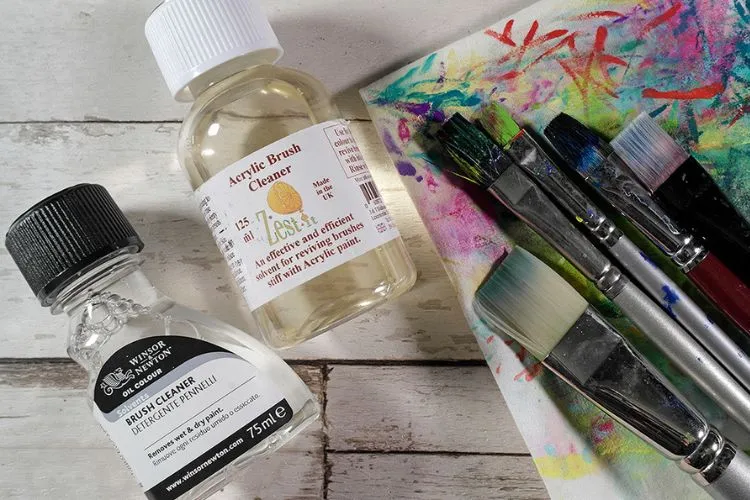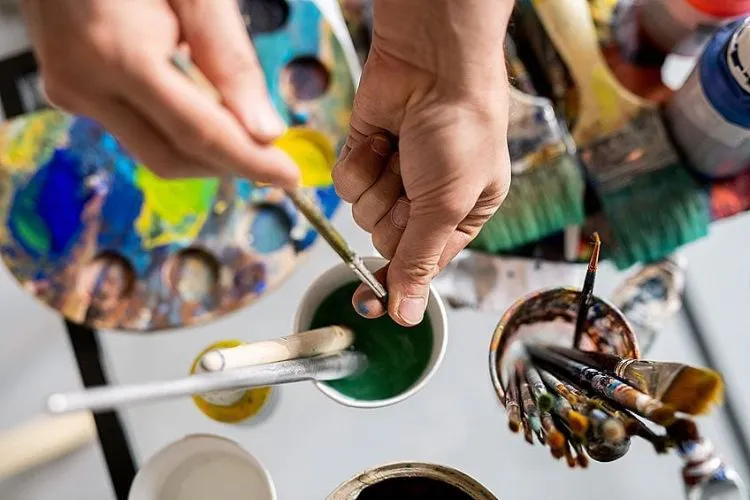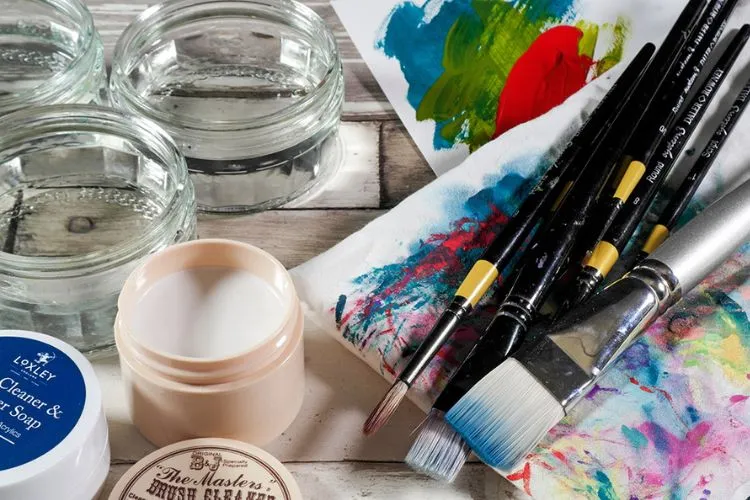Every artist knows the dread that comes with discovering their favorite brush stiff with dried acrylic paint. It’s a common mishap, given the fast-drying nature of acrylics.
Maintaining clean brushes is more than just an upkeep task; it’s essential for the quality of your artwork.
In this article, we’ll explore how to clean dried acrylic Paint Brushes and keep them in peak condition.

Understanding Acrylic Paints
Acrylic paints are beloved for their versatility and vibrant colors. However, they can be unforgiving when left to dry on brushes.
They quickly form a water-resistant layer, making them a challenge to remove once they’ve settled in. Knowing this, we can approach the problem with proper methods to clean and restore our tools.
Immediate Prevention Tips
It’s often said that prevention is better than cure. Clean your brushes right after use to avoid the hassle of hardened paint.
Be mindful that long soaks can damage brush bristles. Taking these immediate steps will save you time and extend the life of your brushes.
Materials Needed

To tackle dried acrylic, you’ll need some essentials. Gather warm water, mild soap, a brush comb, and possibly some vinegar or professional brush cleaner.
Having these supplies at hand prepares you for the cleaning process ahead.
How To Clean Dried Acrylic Paint Brushes?
Initial Assessment
Begin by inspecting your brush. Look at how much paint has built up and where it’s located.
Bristles clumped with paint near the base are a telltale sign that a thorough cleaning is in order.
Sometimes, however, it may be wiser to invest in a new brush if the old one seems beyond repair.
Softening the Paint
To start the revival, try softening the dried paint. Warm soapy water can work wonders on brushes with a moderate amount of paint.
For tougher cases, a soak in a vinegar solution might break down the stubborn acrylic.
Removal Process
With the paint softened, it’s time for removal. Use a brush comb or your fingers to gently tease out the paint.
Alternate this with rinsing to ensure you’re making progress without damaging the fibers.
Deep Cleaning Methods
When basic cleaning doesn’t cut it, deep cleaning methods come into play. There are professional brush cleaners specifically designed to tackle acrylic paint.
Homemade solutions can also work as a backup. The key here is to be gentle yet thorough in your approach.
Drying and Reshaping Brushes
After cleaning, drying and reshaping your brushes are crucial. This will help maintain their shape and utility.
Lay them flat or hang them with bristles facing down to prevent water from loosening the glue at the base.
Maintenance and Storage
Proper storage is just as important as cleaning. Hang brushes or lay them flat in a dust-free area.
By keeping a regular maintenance routine, you can preserve the life of your brushes and ensure they’re ready for your next creative session.
Pro Tips
A little-known trick is using fabric softener to condition natural hair brushes. The right cleaner for your brush type makes a big difference, too. For instance, synthetic brushes may handle tougher cleaners than natural ones.
Troubleshooting Common Problems
It’s not unusual to face challenges while cleaning. If the paint won’t soften, it may require an extended soak or a stronger solution.
And if you find bristles getting damaged, consider switching to a more delicate method or tool for the job.

You may also find useful: How To Revive Acrylic Paint? | How to Make Acrylic Paint Dry Faster?
The Role of Water Temperature in Cleaning Brushes
Choosing the correct water temperature is crucial for effectively cleaning paint brushes while preserving their bristles.
Cold water is gentle on brushes, making it suitable for delicate bristles but less effective at loosening thick, dried paint.
Warm water, however, strikes a balance, effectively loosening and diluting acrylic paint without causing excessive wear on the fibers. It’s ideal for most cleaning scenarios, as it offers a good compromise between efficacy and gentleness.
Hot water can soften and sometimes warp synthetic fibers and overly relax natural hairs, reducing the brush’s lifespan. It might remove paint more rapidly, but it risks damaging the brush structure, including loosening the glue at the ferrule that holds the bristles in place.
Depending on the specifics of the brush and type of paint used, warm water often remains the best choice for combining effective cleaning with brush care.
Homemade Solutions vs. Commercial Cleaners
Homemade solutions for cleaning paint brushes, such as diluted dish soap or vinegar mixtures, offer a cost-effective and environmentally friendly alternative to commercial cleaners.
They are generally safer, both for the artist and the environment, but might struggle with very dried or dense paint accumulations.
Contrastingly, commercial cleaners are designed for optimal effectiveness, cutting through tough paint deposits more efficiently but often at a higher cost and with potential health or environmental risks due to their chemical compositions.
While commercial products can save time and effort, choosing between them and homemade solutions balances concerns of safety, cost, and environmental impact.
Frequently Asked Questions (FAQs)
Can vinegar remove dried acrylic paint from brushes?
Yes, vinegar can be an effective solution for softening and removing dried acrylic paint from brushes.
How often should I deep clean my paint brushes?
A good practice is to deep clean your brushes every few uses or when you notice a buildup affecting their performance.
Is it safe to use nail polish remover for cleaning acrylic paint from brushes?
While nail polish remover can break down acrylic paint, it’s harsh and can damage brush bristles. It should be used with caution and only as a last resort.
Can dried acrylic paint permanently damage brushes?
Unfortunately, if acrylic paint is left to dry for too long or is not properly removed, it can permanently damage brushes.
Conclusion:
Cleaning dried acrylic from brushes may seem daunting, but with the right approach, you can restore them back to life.
Regular cleaning, immediate attention after use, and proper storage are your best defenses against stubborn dried paint.
By investing a bit of time into maintenance, your brushes can last longer and continue to be valuable tools in your artistic endeavors.

Meet Isabella Anderson, your acrylic painting mentor with over a decade of brush-wielding mastery. Dive into the colorful world of acrylics with her expert guidance, featured exclusively on ‘Acrylic Authority.’ Unleash your inner artist and explore the limitless possibilities of this versatile medium alongside a true acrylic aficionado.
